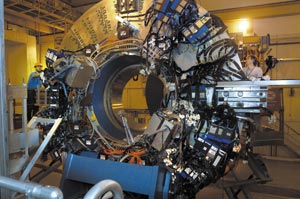
A major milestone has been reached for the STAR detector at Brookhaven’s Relativistic Heavy Ion Collider (RHIC) with the hoisting of the upper half of the endcap electromagnetic calorimeter (EEMC) into place on the “west” STAR magnet poletip. Scientists and engineers looked on with anticipation as this mammoth detector, weighing around 12.5 tonnes, was gently lowered into place, completing the mechanical installation of a key upgrade for the STAR collaboration’s spin-physics programme.
Together with the barrel electromagnetic calorimeter, the EEMC provides STAR with the capability to probe deeply into the proton’s spin structure. Specifically, the EEMC will provide forward-angle detection, identification and trigger capability for photons, electrons, positrons and electromagnetically decaying mesons. It is a key element of STAR’s plan to use polarized proton beams at centre-of-mass energies up to 500 GeV to study the gluon contribution to the proton spin and flavour-dependence (ubar vs dbar) of the sea-quark polarization.

The main thrust of the spin programme at RHIC is to add significantly to our knowledge of the spin structure of the nucleon. With the addition of electromagnetic calorimetry, STAR will provide important new information on the gluon contribution to the proton spin (ΔG(x)) by looking at the QCD Compton scattering channel, which results in a direct photon and jet. This channel is particularly “clean” in that the only other QCD subprocess that contributes is quark-antiquark annihilation, a relatively small consideration at RHIC energies. The large solid angle of STAR is ideally suited for detecting the jet and photon in coincidence, providing unique kinematic information allowing the extraction of ΔG as a function of the momentum fraction x. The EEMC is crucial to reaching the low x portion of ΔG(x) and also provides essential solid angle for the detection of high-energy electrons from parity-violating W decays, which will allow flavour-separated measurements of the polarization of the up and down antiquark sea.
A traditional lead/plastic scintillator sampling calorimeter, the EEMC is about 5 m in diameter and weighs 25 tonnes overall. It consists of 23 layers of lead (laminated with thin stainless steel for strength) between 24 layers of scintillator, resulting in 21 radiation lengths of material at normal incidence to provide a linear response for energies from 1-150 GeV.
The active area of the EEMC covers a range in pseudorapidity of 1.09 < η 2 (37.2° > θ > 15.2°). The acceptance is segmented into 720 projective towers assembled from 17 280 scintillator tiles. The signals are collected in wavelength-shifting fibres and carried via clear optical fibres (the black cables in the upper left of figure 1) to 720 photomultiplier tubes (PMTs) on the back of the magnet poletip. In addition, the detector provides fast trigger capabilities and pre- and post-shower signals valuable for electron/hadron discrimination.
Photon/π0 discrimination in the range 10-40 GeV is critical for measuring ΔG(x). Thus a shower maximum detector, consisting of two planes of triangular scintillator strips (1 cm wide) with coaxial wavelength shifting fibres, is included. The ~9000 shower maximum detector and pre- and post-shower signals are read out with 16-anode PMTs, digitized every 110 ns and stored in a digital delay line. The innovative, miniaturized read-out electronics, incorporating a 12-bit ADC for each channel, mounts directly behind a thin (9 mm) Cockroft-Walton base on each PMT. Thus 12 PMTs, bases and read-out electronics for 192 channels all reside in a compact magnetically shielded box with a single data fibre output.
The lower half of the mechanical structure and one-third of the tower energy read-out was installed and instrumented in autumn 2002. This was commissioned during the RHIC III run and provided useful tower information. The RHIC IV run began in November 2003 and the full EEMC is ready to provide energy signals and triggering. A significant block of the shower maximum and pre/post-shower detectors is also instrumented. These EEMC subsystems, as well as the barrel electromagnetic calorimeter, will be completed in the next RHIC shutdown.
The construction of the EEMC, funded primarily by the National Science Foundation, has been underway for about three years, led by a group from Indiana University with collaborators from Argonne National Laboratory, Brookhaven National Laboratory, Creighton University, the Joint Institute for Nuclear Research, Kent State University, Michigan State University, Texas A&M University and Valparaiso University.
Further reading
C Allgower et al. 2003 Nucl. Ins. Meth. A 499 740.
M Beddo et al. 2003 Nucl. Ins. Meth. A 499 725.





